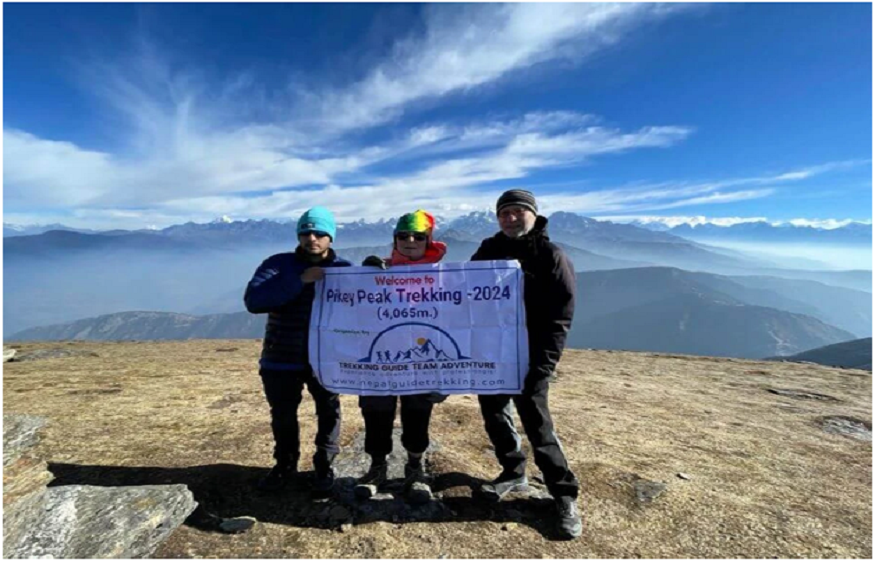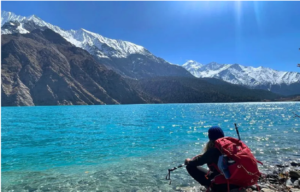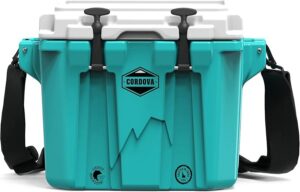
Your Guide to Nepal’s Top Treks
Pikey peak Trekking
Pikey peak trekking is a covered up diamond in the lower Everest region that offers breathtaking all encompassing views of the Himalayan run. This trek is perfect for those looking for a shorter and less swarmed trekking involvement whilst still being remunerated with a shocking view. Pikey peak (4,065 meters) is known for its dawn and dusk views over the towering peaks, counting Mount Everest, Makalu, Kanchenjunga, and more. The trek gives a one of a kind opportunity to investigate the Sherpa culture, Buddhist religious communities, and conventional mountain villages.
The course ordinarily begins from Dhap or Jiri, passing through lavish timberlands of rhododendron and pine, and proceeds through pleasant towns like Japre and Lamjura. Along the way, trekkers experience antiquated religious communities, chortens, and supplication banners, reflecting the region’s otherworldly importance. The Pikey peak perspective itself is the highlight, advertising 360-degree sees of a few of the tallest peaks in the world. This trek is directly in trouble, making it open to both amateur and experienced trekkers.
Langtang-Gosaikunda-Helambu Trek
The Langtang-Gosaikunda-Helambu trek combines three unmistakable districts, giving a differing and immersive trekking encounter. This trek offers a mix of lavish valleys, elevated knolls, sacrosanct lakes, and wealthy social legacy. Arranged to the north of Kathmandu, the Langtang Valley is known for its dazzling scenes, whereas Gosaikunda is a venerated trek location with its flawless, high-altitude lakes. The Helambu region includes a social measurement with its special Tamang and Hyolmo communities.
The trek as a rule starts from Syabrubesi and rises through Langtang National Stop, domestic to ruddy pandas and other natural life. Trekkers navigate through thick woodlands, charming towns like Langtang and Kyanjin Gompa, and rise to the sacrosanct Gosaikunda Lake at 4,380 meters. The path at that point plummets through the beautiful Helambu region, concluding at Sundarijal. This trek is tolerably challenging, with a few soak climbs and high-altitude segments, but the social and common rewards are well worth the effort.
Everest Base Camp Cho La Pass and Gokyo trek (16 Days)
The Everest Base Camp Cho La Pass and Gokyo trek is an exciting and comprehensive trip through the heart of the Everest region. This trek combines the notorious Everest Base Camp with the challenging Cho La Pass (5,420 meters) and the perfect Gokyo Lakes. It is a culminating choice for explorers looking for a mix of high-altitude trekking, frigid scenes, and breathtaking mountain vistas.
Starting from Lukla, the path takes after the classic EBC course through Namche Bazaar, Tengboche, and Gorak Shep some time recently coming to Everest Base Camp (5,364 meters). After celebrating the accomplishment at the base of the world’s tallest mountain, trekkers cross the Cho La Pass to enter the Gokyo Valley. The turquoise Gokyo Lakes and the all encompassing sea from Gokyo Ri (5,357 meters) are among the trek’s highlights. This challenging trek requires physical perseverance and acclimatization but rewards trekkers with unparalleled Himalayan experiences.
Gokyo Renjo La Pass Trekking (15 Days)
The Gokyo Renjo La Pass Trekking course offers a less-traveled but similarly shocking elective to the classic Everest Base Camp trek. This trek takes you through the quiet Gokyo Valley, past the shimmering Gokyo Lakes, and over the Renjo La Pass (5,360 meters), giving emotional views of Everest, Lhotse, Makalu, and Cho Oyu. The trek is idealized for those looking for isolation and a special viewpoint of the Everest region.
The trip starts in Lukla and takes after the Dudh Koshi Stream to Namche Bazaar, the bustling portal to the Everest region. From here, the path veers toward Gokyo, where the shining cold lakes anticipate. The climb to Renjo La Pass is challenging but offers one of the most marvelous scenes in the region. After crossing the pass, the path slips through farther Sherpa towns some time recently returning to Lukla. This trek is appropriate for experienced trekkers looking for enterprise past the well-trodden paths.
Why Select These Treks
Each of these treks offers an interesting mix of characteristic excellence, social lavishness, and enterprise. Pikey peak trek culminates for those who need shocking sees without the swarms. The Langtang-Gosaikunda-Helambu trek gives a differing encounter with sacrosanct destinations and social experiences. The Everest Base Camp Cho La Pass and Gokyo trek is a dream for those needing to combine the classic EBC involvement with extra experience through tall mountain passes and frigid lakes. In the interim, the Gokyo Renjo La Pass trek is perfect for trekkers looking for an off-the-beaten-path travel with fabulous vistas.
Best Time for These Treks
The best time to embrace these treks is amid the pre-monsoon (spring) and post-monsoon (harvest time) seasons. Spring (March to May) offers blooming rhododendrons and direct temperatures, whereas harvest time (September to November) gives clear skies and great mountain perceivability. Winter treks are conceivable but can be challenging due to snow, particularly on tall passes like Cho La and Renjo La. Storm season (June to Admirable) is not prescribed due to overwhelming precipitation and dangerous trails.
Highlights and Routes for These Treks
Pikey peak trek: All encompassing sees of Everest and encompassing peaks, Sherpa culture, religious communities, and elevated landscapes.
Langtang-Gosaikunda-Helambu trek: Langtang Valley’s common magnificence, sacrosanct Gosaikunda Lake, social inundation in Tamang and Hyolmo villages.
Everest Base Camp Cho La Pass and Gokyo trek: Everest Base Camp, Cho La Pass, Gokyo Lakes, Gokyo Ri summit, and assorted Himalayan scenery.
Gokyo Renjo La Pass trek: Gokyo Lakes, Renjo La Pass, sees four 8,000-meter peaks, and farther Sherpa villages.
Planning and Preparation
Proper arranging is fundamental for an effective trekking involvement. Guarantee you have the required grants: the TIMS card (Trekkers’ Data Administration Framework) and fundamental national stop licenses. Physical arrangement ought to incorporate cardiovascular works out and quality preparing to move forward stamina and continuance. Acclimatization days are pivotal, particularly for high-altitude treks like Everest Base Camp and Gokyo.
Accommodation and Food
Teahouses are the essential frame of settlement on these treks, advertising fundamental however comfortable lodging. Rooms regularly incorporate twin beds with shared washrooms. Dinners incorporate an assortment of Nepali and universal alternatives, such as dal bhat (rice and lentils), noodles, soups, and hotcakes. Whereas nourishment is ample, the accessibility of new creations diminishes with height. Carrying snacks and water refinement tablets is advisable.
Tips to successful tour
Train in Development: Construct cardiovascular wellness and reinforce your legs with customary climbs and workouts.
Pack Savvy: Incorporate layers for changing climate, tough trekking boots, and basic adaptations like a resting sack and trekking poles.
Hydrate and Acclimate: Drink bounty of water and take after suggested acclimatization schedules.
Travel Protections: Guarantee it covers high-altitude trekking and crisis evacuations.
Respect Neighborhood Culture: Take after neighborhood traditions and bolster economical tourism by minimizing waste.
Conclusion
Nepal’s trekking trails offer unparalleled openings to encounter the glory of the Himalayas whereas inundating yourself in different societies and scenes. Whether you pick for the picturesque Pikey peak, the otherworldly Langtang-Gosaikunda-Helambu course, the gutsy Everest Base Camp Cho La Pass and Gokyo trek, or the farther Gokyo Renjo La Pass travel, each guarantees a one of a kind and extraordinary enterprise. With cautious arranging and planning, these treks can be both fulfilling and transformative.
FAQs
1. Which trek is the most straightforward among these options?
Pikey peak trek is the most straightforward, with direct risings and lower heights compared to the other treks.
2. Do I require a direct for these treks?
While it is conceivable to trek autonomously, enlisting a direct improves security, gives nearby bits of knowledge, and helps with navigation.
3. What grants are required?
You will require a TIMS card and individual national stop licenses for all these treks.
4. How challenging are the Cho La and Renjo La Passes?
Both passes are requested due to soak climbs and tall heights, requiring physical wellness and acclimatization.
5. Can I do these treks year-round?
Spring and harvest time are perfect, whereas winter is challenging due to snow. Rainstorms are for the most part unacceptable due to overwhelming downpours and destitute perceivability.
Booking Process byTrekking Guide Team Adventure :
To book any of these treks tours through Trekking Guide Team Adventure Pvt. Ltd., begin by contacting them via email at info@nepalguidetrekking.com or phone or WhatsApp at +977 9851229400 to discuss your preferred dates, group size, and specific needs. They will provide a detailed itinerary covering these trek’s duration, highlights, cost, and inclusions such as a guide, porter, meals, accommodation, and transportation.
Prior to the trek, you will receive a comprehensive pre-trek briefing with essential information on packing, fitness preparation, and altitude acclimatization. The agency will finalize all logistical arrangements, including transportation, accommodation, and permits, to ensure everything is in place for your trek. Upon arrival in Nepal, the team will ensure that all aspects of the trek are organized, providing you with a smooth and unforgettable experience on these treks.


